A Region-Growing Segmentation Approach to Delineating Timberline from Satellite-Derived Tree Fractional Cover Products
Abstract
1. Introduction
2. Method
2.1. Study Materials
2.2. Timberline Delineation
2.2.1. Seed Extraction from Continuous Forests
2.2.2. Region-Growing Segmentation
2.3. Evaluation and Comparison of the Mapped Timberline
3. Results
3.1. Timberline Delineation
3.2. Comparison of the Delineated Timberline with the CAVM Treeline, the TTE Mapped by Ranson et al. (2011) [12], and the Non-Forest Edge Classes Mapped by Montesano et al. (2020) [11]
4. Discussion
4.1. Tree Encroachment at Regional Scales
4.2. Quality of the Source Tree fCover Data in Timberline Mapping
5. Conclusions
Author Contributions
Funding
Data Availability Statement
Acknowledgments
Conflicts of Interest
Appendix A
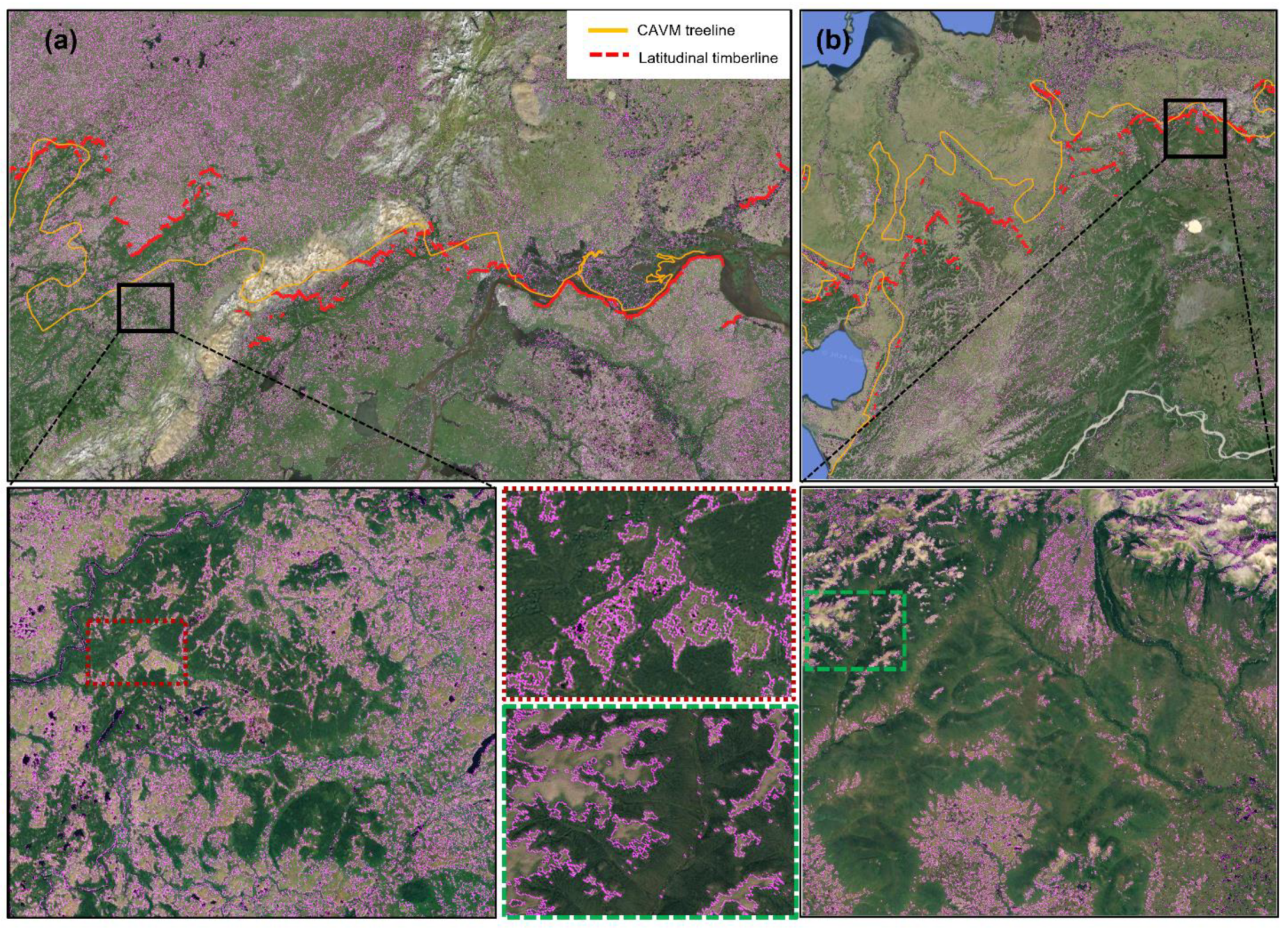
References
- Harsch, M.A.; Hulme, P.E.; McGlone, M.S.; Duncan, R.P. Are Treelines Advancing? A Global Meta-Analysis of Treeline Response to Climate Warming. Ecol. Lett. 2009, 12, 1040–1049. [Google Scholar] [CrossRef] [PubMed]
- Hofgaard, A.; Ols, C.; Drobyshev, I.; Kirchhefer, A.J.; Sandberg, S.; Söderström, L. Non-Stationary Response of Tree Growth to Climate Trends Along the Arctic Margin. Ecosystems 2019, 22, 434–451. [Google Scholar] [CrossRef]
- Hofgaard, A.; Wilmann, B. Plant Distribution Pattern across the Forest-Tundra Ecotone: The Importance of Treeline Position. Écoscience 2002, 9, 375–385. [Google Scholar] [CrossRef]
- Jobbágy, E.G.; Jackson, R.B. Global Controls of Forest Line Elevation in the Northern and Southern Hemispheres. Glob. Ecol. Biogeogr. 2000, 9, 253–268. [Google Scholar] [CrossRef]
- Timoney, K.P.; Mamet, S.D.; Cheng, R.; Lee, P.; Robinson, A.L.; Downing, D.; Wein, R.W. Tree Cover Response to Climate Change in the Forest-Tundra of North-Central Canada: Fire-Driven Decline, Not Northward Advance. Écoscience 2019, 26, 133–148. [Google Scholar] [CrossRef]
- Cunill, R.; Pelachs, A.; Soriano, J.M. The Consequences on Landscape of New Land Uses in the Upper Forest Line. In Naturbanization: New Identities and Processes for Rural-Natural Areas; CRC Press: Boca Raton, FL, USA, 2008; pp. 247–260. [Google Scholar]
- Motta, R.; Morales, M.; Nola, P. Human Lands-Use, Forest Dynamics and Tree Growth at the Treeline in the Western Italian Alps. Ann. For. Sci. 2006, 63, 739–747. [Google Scholar] [CrossRef]
- Latwal, A.; Sah, P.; Sharma, S. A Cartographic Representation of a Timberline, Treeline and Woody Vegetation around a Central Himalayan Summit Using Remote Sensing Method. Trop. Ecol. 2018, 59, 177–186. [Google Scholar]
- Walther, C.; Hüttich, C.; Urban, M.; Schmullius, C. Modelling the Arctic Taiga-Tundra Ecotone Using ALOS PALSAR and Optical Earth Observation Data. Int. J. Appl. Earth Obs. Geoinf. 2019, 81, 195–206. [Google Scholar] [CrossRef]
- Callaghan, T.V.; Werkman, B.R.; Crawford, R.M. The Tundra-Taiga Interface and Its Dynamics: Concepts and Applications. Ambio 2002, 12, 6–14. [Google Scholar]
- Montesano, P.M.; Neigh, C.S.R.; Macander, M.; Feng, M.; Noojipady, P. The Bioclimatic Extent and Pattern of the Cold Edge of the Boreal Forest: The Circumpolar Taiga-Tundra Ecotone. Environ. Res. Lett. 2020, 15, 105019. [Google Scholar] [CrossRef]
- Ranson, K.J.; Montesano, P.M.; Nelson, R. Object-Based Mapping of the Circumpolar Taiga–Tundra Ecotone with MODIS Tree Cover. Remote Sens. Environ. 2011, 115, 3670–3680. [Google Scholar] [CrossRef]
- Walker, D.A.; Raynolds, M.K.; Daniëls, F.J.A.; Einarsson, E.; Elvebakk, A.; Gould, W.A.; Katenin, A.E.; Kholod, S.S.; Markon, C.J.; Melnikov, E.S.; et al. The Circumpolar Arctic Vegetation Map. J. Veg. Sci. 2005, 16, 267–282. [Google Scholar] [CrossRef]
- Prakash Singh, C.; Mohapatra, J.; Pandya, H.A.; Gajmer, B.; Sharma, N.; Shrestha, D.G. Evaluating Changes in Treeline Position and Land Surface Phenology in Sikkim Himalaya. Geocarto Int. 2020, 35, 453–469. [Google Scholar] [CrossRef]
- Van Bogaert, R.; Haneca, K.; Hoogesteger, J.; Jonasson, C.; De Dapper, M.; Callaghan, T.V. A Century of Tree Line Changes in Sub-Arctic Sweden Shows Local and Regional Variability and Only a Minor Influence of 20th Century Climate Warming. J. Biogeogr. 2011, 38, 907–921. [Google Scholar] [CrossRef]
- Myers-Smith, I.H.; Kerby, J.T.; Phoenix, G.K.; Bjerke, J.W.; Epstein, H.E.; Assmann, J.J.; John, C.; Andreu-Hayles, L.; Angers-Blondin, S.; Beck, P.S.A.; et al. Complexity Revealed in the Greening of the Arctic. Nat. Clim. Change 2020, 10, 106–117. [Google Scholar] [CrossRef]
- Carroll, M.; Townshend, J.; Hansen, M.; DiMiceli, C.; Sohlberg, R.; Wurster, K. MODIS Vegetative Cover Conversion and Vegetation Continuous Fields. In Land Remote Sensing and Global Environmental Change; Springer: Berlin/Heidelberg, Germany, 2010; pp. 725–745. [Google Scholar]
- Sexton, J.O.; Song, X.-P.; Feng, M.; Noojipady, P.; Anand, A.; Huang, C.; Kim, D.-H.; Collins, K.M.; Channan, S.; DiMiceli, C.; et al. Global, 30-m Resolution Continuous Fields of Tree Cover: Landsat-Based Rescaling of MODIS Vegetation Continuous Fields with Lidar-Based Estimates of Error. Int. J. Digit. Earth 2013, 6, 427–448. [Google Scholar] [CrossRef]
- Hansen, M.C.; Potapov, P.V.; Moore, R.; Hancher, M.; Turubanova, S.A.; Tyukavina, A.; Thau, D.; Stehman, S.V.; Goetz, S.J.; Loveland, T.R.; et al. High-Resolution Global Maps of 21st-Century Forest Cover Change. Science 2013, 342, 850–853. [Google Scholar] [CrossRef]
- Liu, Y.; Liu, R.; Qi, L.; Chen, J.; Dong, J.; Wei, X. Global Mapping of Fractional Tree Cover for Forest Cover Change Analysis. ISPRS J. Photogramm. Remote Sens. 2024, 211, 67–82. [Google Scholar] [CrossRef]
- Buchhorn, M.; Lesiv, M.; Tsendbazar, N.-E.; Herold, M.; Bertels, L.; Smets, B. Copernicus Global Land Cover Layers—Collection 2. Remote Sens. 2020, 12, 1044. [Google Scholar] [CrossRef]
- Brown, C.F.; Brumby, S.P.; Guzder-Williams, B.; Birch, T.; Hyde, S.B.; Mazzariello, J.; Czerwinski, W.; Pasquarella, V.J.; Haertel, R.; Ilyushchenko, S. Dynamic World, Near Real-Time Global 10 m Land Use Land Cover Mapping. Sci. Data 2022, 9, 251. [Google Scholar] [CrossRef]
- Adams, R.; Bischof, L. Seeded Region Growing. IEEE Trans. Pattern Anal. Mach. Intell. 1994, 16, 641–647. [Google Scholar] [CrossRef]
- Tsendbazar, N.-E.; Tarko, A.; Li, L.; Herold, M.; Lesiv, M.; Fritz, S.; Maus, V. Copernicus Global Land Service: Land Cover 100m: Version 3 Globe 2015–2019: Validation Report; Zenodo: Geneve, Switzerland, 2020. [Google Scholar]
- Özcan, A.H.; Ünsalan, C.; Reinartz, P. Ground Filtering and DTM Generation from DSM Data Using Probabilistic Voting and Segmentation. Int. J. Remote Sens. 2018, 39, 2860–2883. [Google Scholar] [CrossRef]
- Cai, S.; Liu, D.; Sulla-Menashe, D.; Friedl, M.A. Enhancing MODIS Land Cover Product with a Spatial–Temporal Modeling Algorithm. Remote Sens. Environ. 2014, 147, 243–255. [Google Scholar] [CrossRef]
- Liu, D.; Cai, S. A Spatial-Temporal Modeling Approach to Reconstructing Land-Cover Change Trajectories from Multi-Temporal Satellite Imagery. Ann. Assoc. Am. Geogr. 2012, 102, 1329–1347. [Google Scholar] [CrossRef]
- Král, K. Classification of Current Vegetation Cover and Alpine Treeline Ecotone in the Praděd Reserve (Czech Republic), Using Remote Sensing. Mt. Res. Dev. 2009, 29, 177–183. [Google Scholar] [CrossRef]
- Ranson, K.J.; Sun, G.; Kharuk, V.I.; Kovacs, K. Assessing Tundra–Taiga Boundary with Multi-Sensor Satellite Data. Remote Sens. Environ. 2004, 93, 283–295. [Google Scholar] [CrossRef]
- Kong, T.Y.; Rosenfeld, A. Topological Algorithms for Digital Image Processing; Elsevier: Amsterdam, The Netherlands, 1996. [Google Scholar]
- Soille, P. Morphological Image Analysis; Springer: Berlin/Heidelberg, Germany, 2004; ISBN 978-3-642-07696-1. [Google Scholar]
- Timoney, K.P.; la Roi, G.H.; Zoltai, S.C.; Robinson, A.L. The High Subarctic Forest-Tundra of Northwestern Canada: Position, Width, and Vegetation Gradients in Relation to Climate. Arctic 1992, 45, 1–9. [Google Scholar] [CrossRef]
- Montesano, P.M.; Neigh, C.S.R.; Sexton, J.; Feng, M.; Channan, S.; Ranson, K.J.; Townshend, J.R. Calibration and Validation of Landsat Tree Cover in the Taiga−Tundra Ecotone. Remote Sens. 2016, 8, 551. [Google Scholar] [CrossRef]
- Cazzolla Gatti, R.; Callaghan, T.; Velichevskaya, A.; Dudko, A.; Fabbio, L.; Battipaglia, G.; Liang, J. Accelerating Upward Treeline Shift in the Altai Mountains under Last-Century Climate Change. Sci. Rep. 2019, 9, 7678. [Google Scholar] [CrossRef]
- MacDonald, G.M.; Kremenetski, K.V.; Beilman, D.W. Climate Change and the Northern Russian Treeline Zone. Phil. Trans. R. Soc. B 2008, 363, 2283–2299. [Google Scholar] [CrossRef]
- Zhou, W.; Mazepa, V.; Shiyatov, S.; Shalaumova, Y.V.; Zhang, T.; Liu, D.; Sheshukov, A.; Wang, J.; El Sharif, H.; Ivanov, V. Spatiotemporal Dynamics of Encroaching Tall Vegetation in Timberline Ecotone of the Polar Urals Region, Russia. Environ. Res. Lett. 2021, 17, 014017. [Google Scholar] [CrossRef]
- Mathisen, I.E.; Mikheeva, A.; Tutubalina, O.V.; Aune, S.; Hofgaard, A. Fifty Years of Tree Line Change in the Khibiny Mountains, Russia: Advantages of Combined Remote Sensing and Dendroecological Approaches. Appl. Veg. Sci. 2014, 17, 6–16. [Google Scholar] [CrossRef]
- Bryn, A.; Potthoff, K. Assessing the Impact of Climate Change Versus Land Use on Tree- and Forest Line Dynamics in Norway. In Mountain Landscapes in Transition: Effects of Land Use and Climate Change; Schickhoff, U., Singh, R.B., Mal, S., Eds.; Sustainable Development Goals Series; Springer International Publishing: Cham, Switzerland, 2022; pp. 613–626. ISBN 978-3-030-70238-0. [Google Scholar]
- Harsch, M.A.; Bader, M.Y. Treeline Form—A Potential Key to Understanding Treeline Dynamics. Glob. Ecol. Biogeogr. 2011, 20, 582–596. [Google Scholar] [CrossRef]
- Bader, M.Y.; Llambí, L.D.; Case, B.S.; Buckley, H.L.; Toivonen, J.M.; Camarero, J.J.; Cairns, D.M.; Brown, C.D.; Wiegand, T.; Resler, L.M. A Global Framework for Linking Alpine-Treeline Ecotone Patterns to Underlying Processes. Ecography 2021, 44, 265–292. [Google Scholar] [CrossRef]
- Gao, Y.; Ghilardi, A.; Mas, J.-F.; Quevedo, A.; Paneque-Gálvez, J.; Skutsch, M. Assessing Forest Cover Change in Mexico from Annual MODIS VCF Data (2000–2010). Int. J. Remote Sens. 2018, 39, 7901–7918. [Google Scholar] [CrossRef]
- Timoney, K.P.; Mamet, S. No Treeline Advance over the Last 50 Years in Subarctic Western and Central Canada and the Problem of Vegetation Misclassification in Remotely Sensed Data. Écoscience 2020, 27, 93–106. [Google Scholar] [CrossRef]
- Montesano, P.M.; Sun, G.; Dubayah, R.O.; Ranson, K.J. Spaceborne Potential for Examining Taiga–Tundra Ecotone Form and Vulnerability. Biogeosciences 2016, 13, 3847–3861. [Google Scholar] [CrossRef]
- Treml, V.; Hejda, T.; Kašpar, J. Differences in Growth between Shrubs and Trees: How Does the Stature of Woody Plants Influence Their Ability to Thrive in Cold Regions? Agric. For. Meteorol. 2019, 271, 54–63. [Google Scholar] [CrossRef]
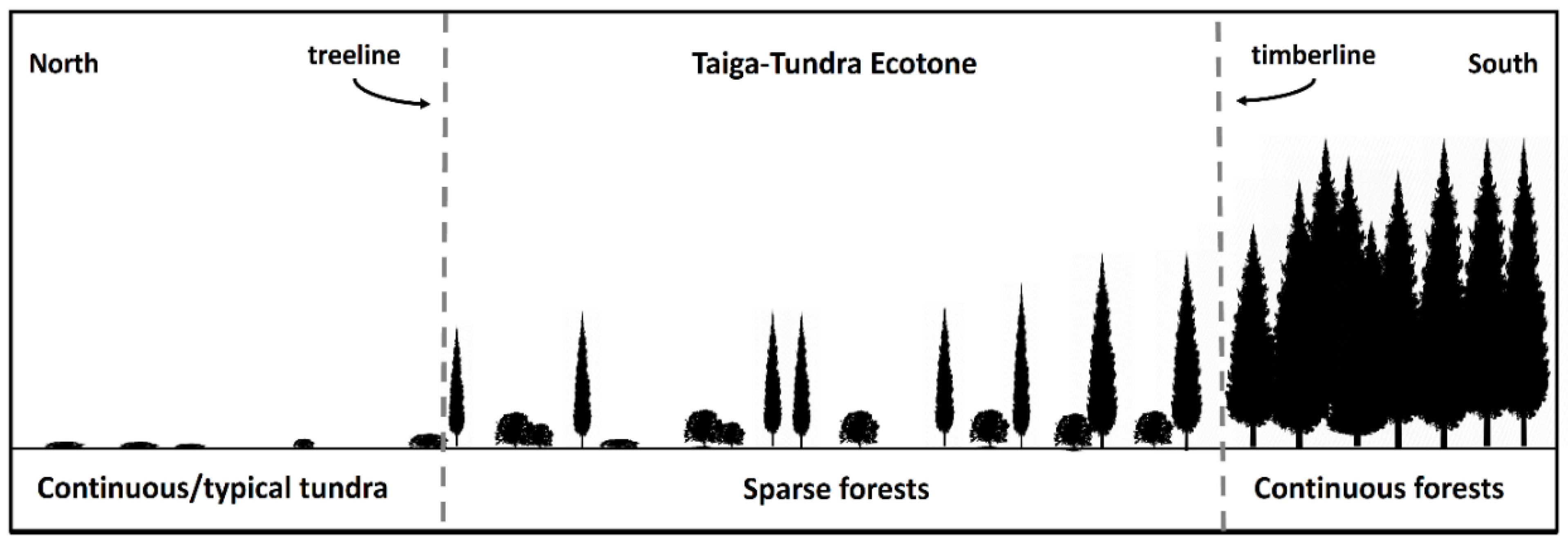
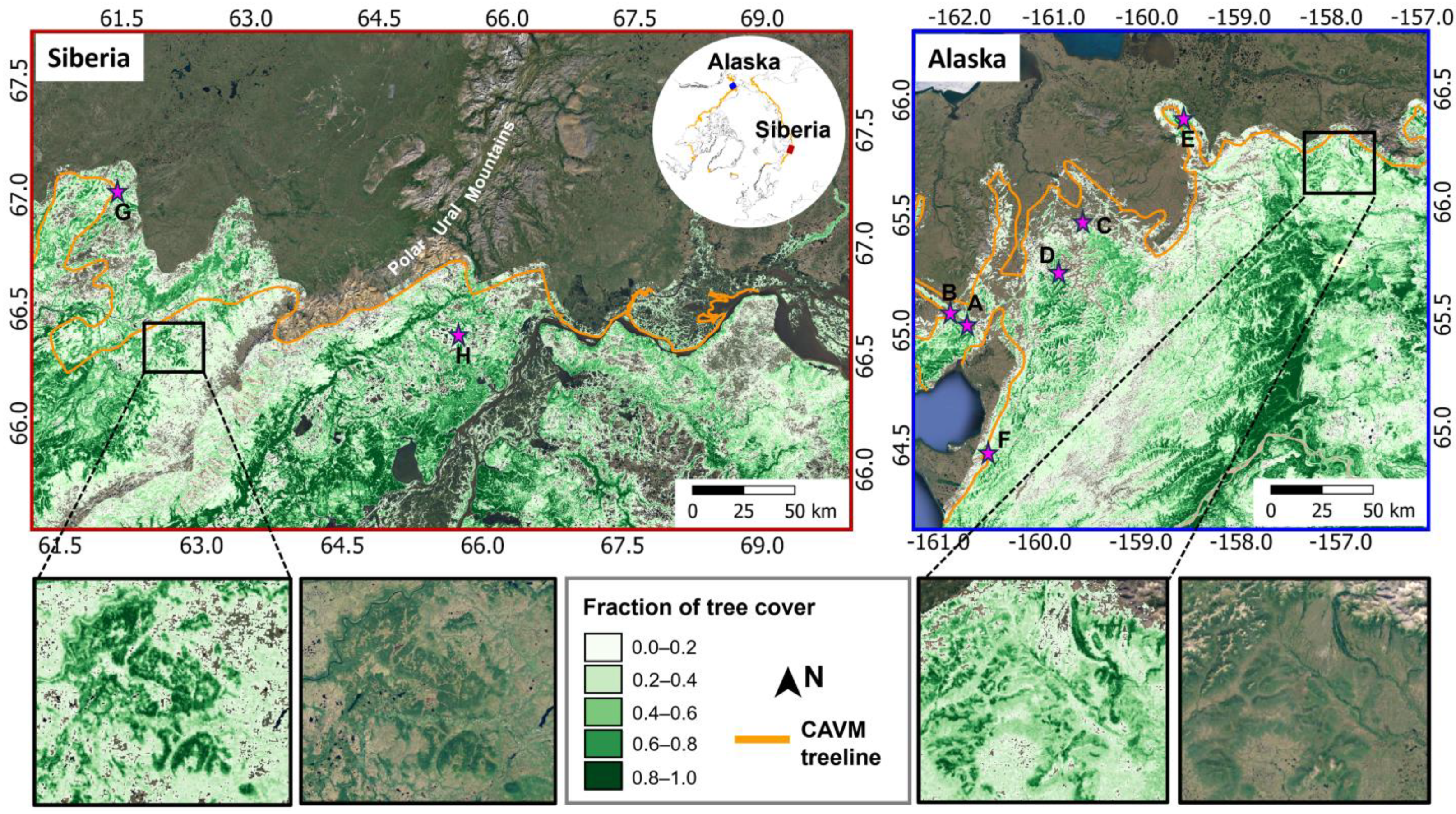
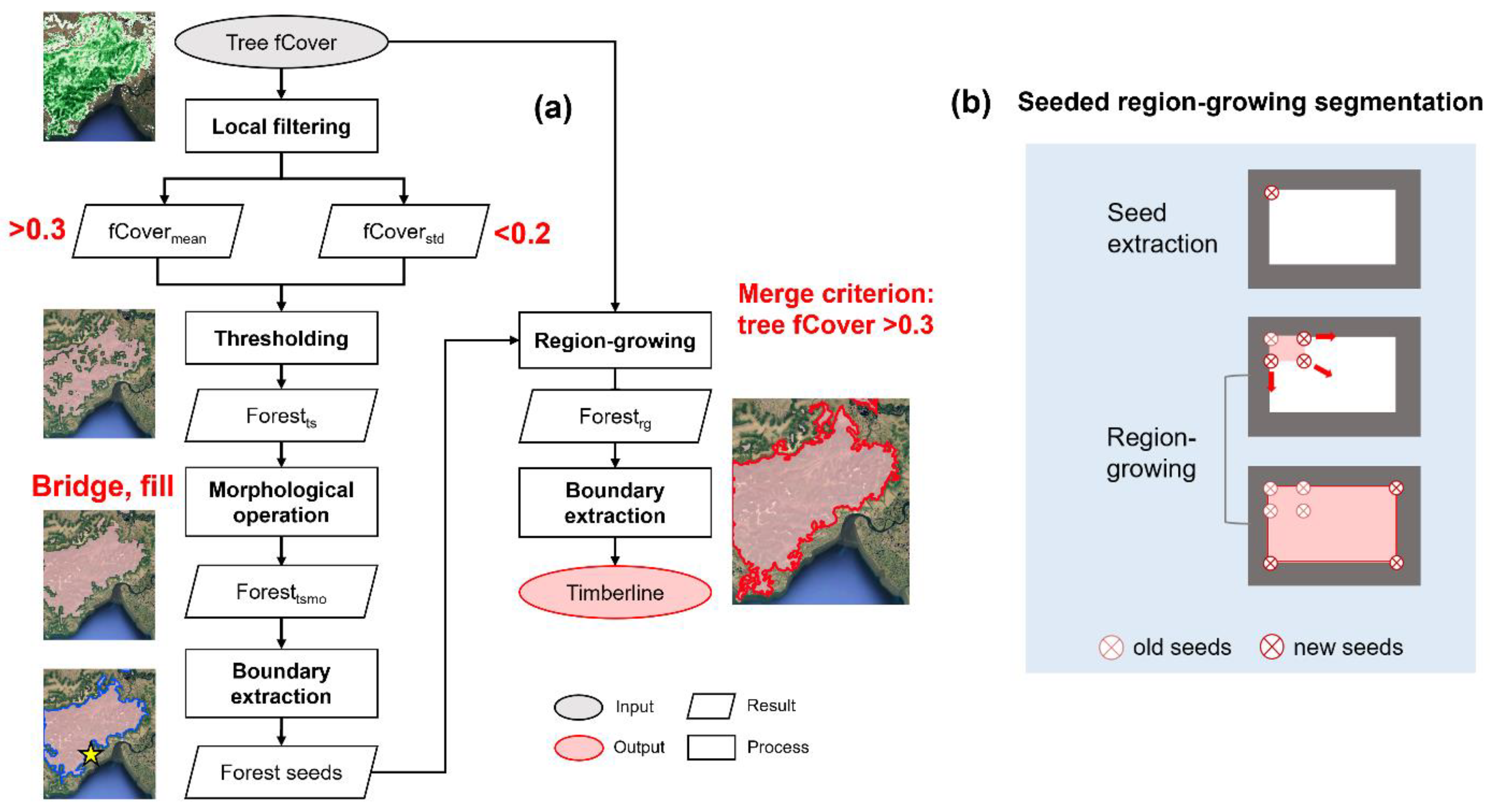
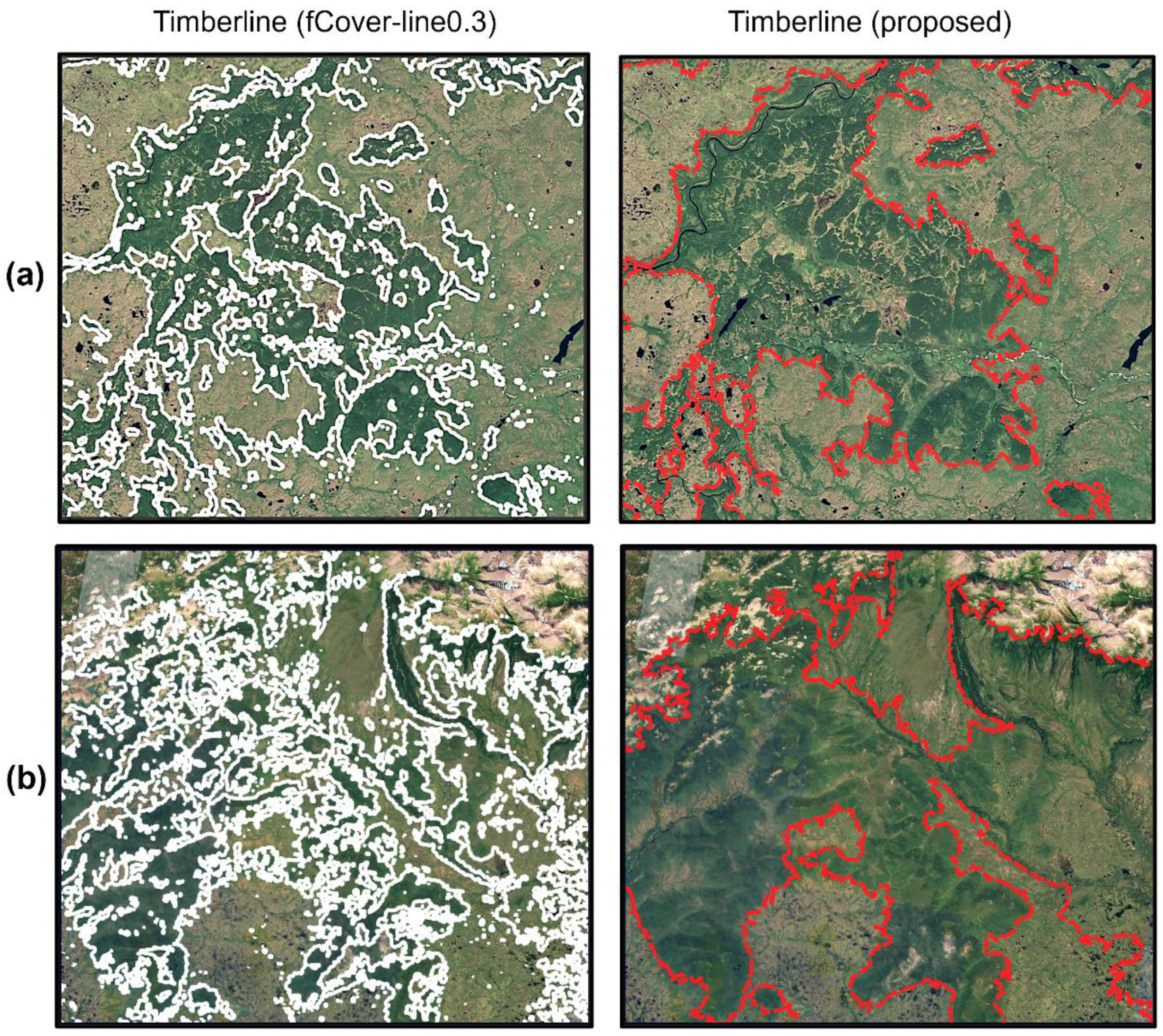
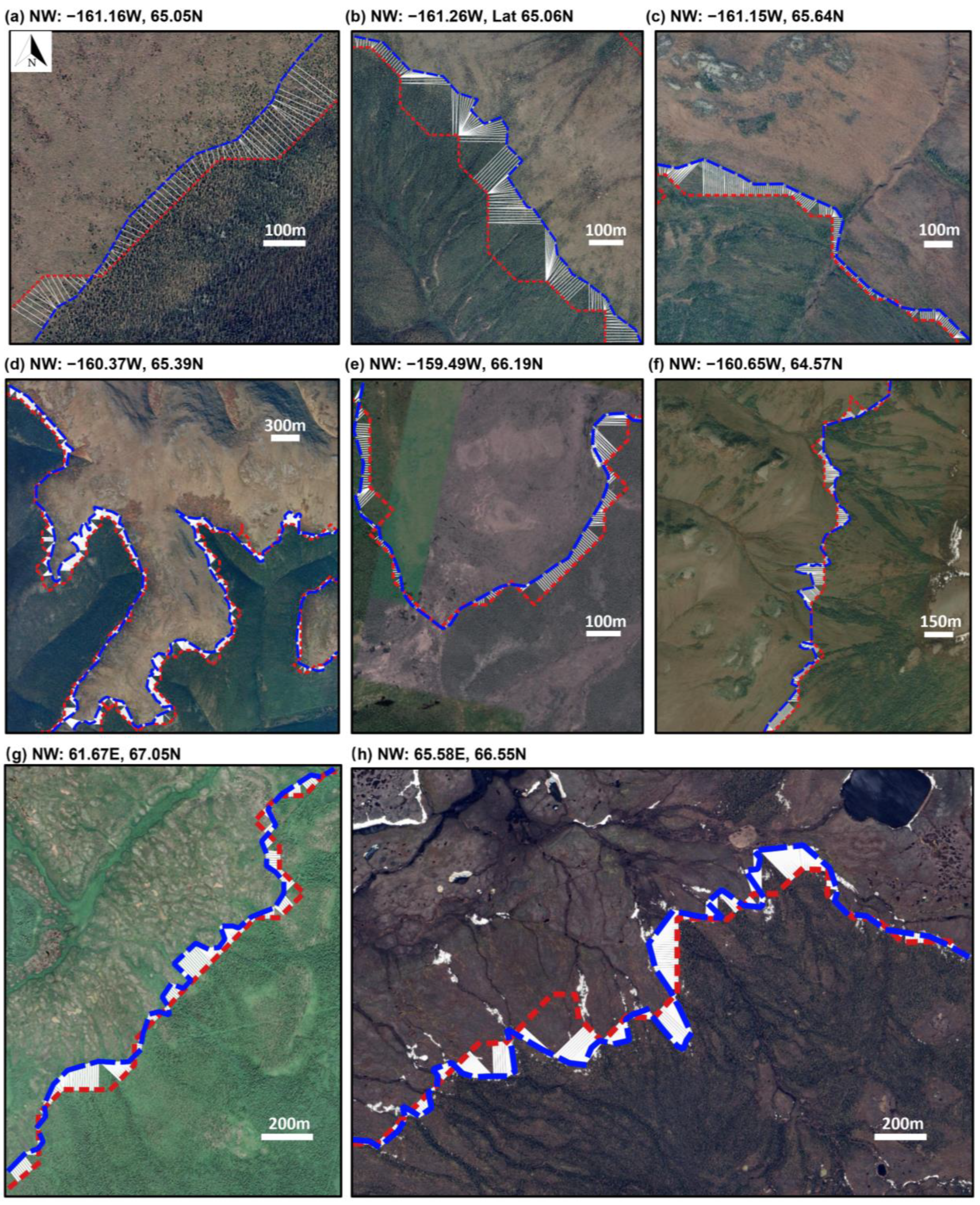
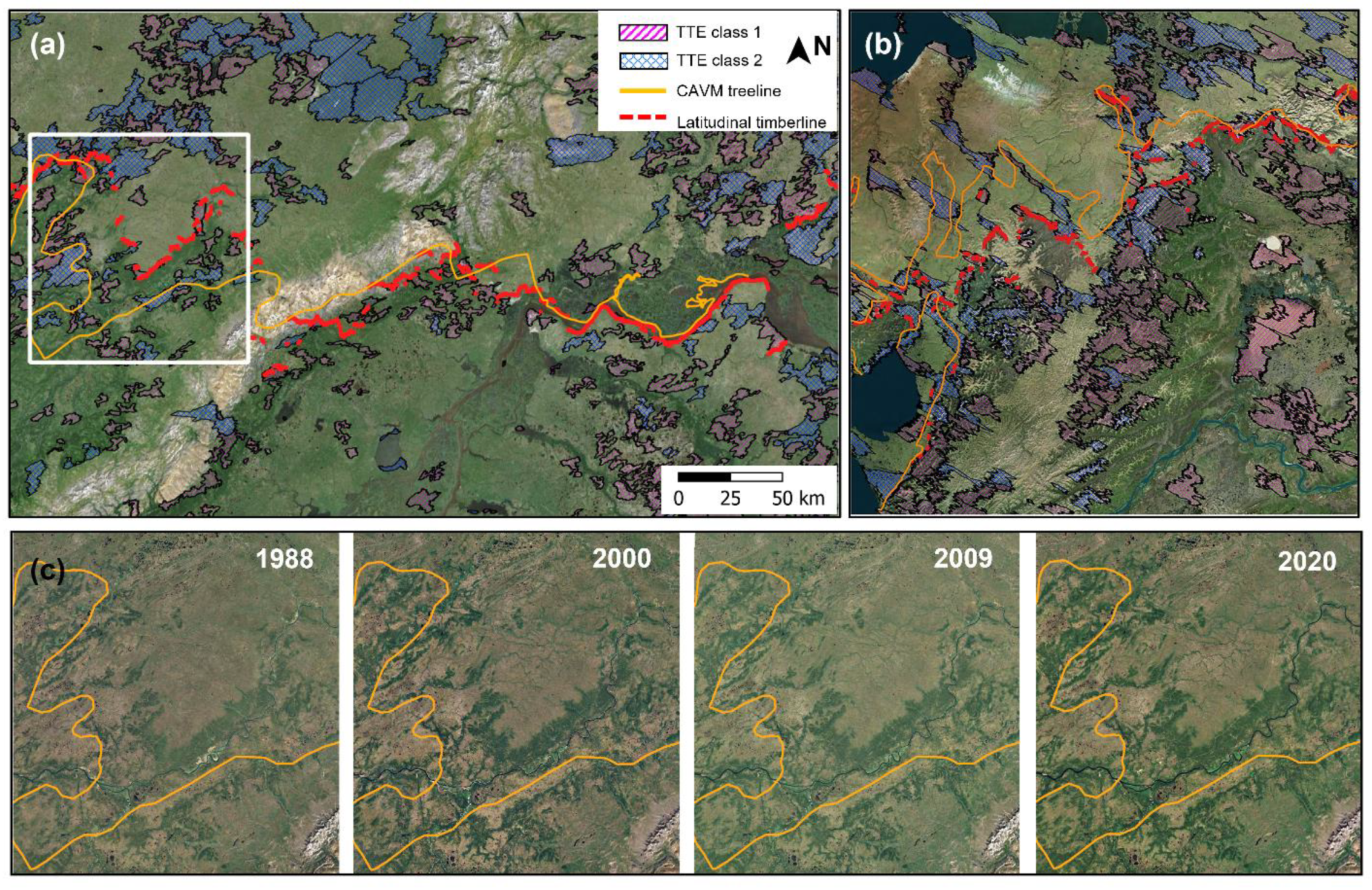
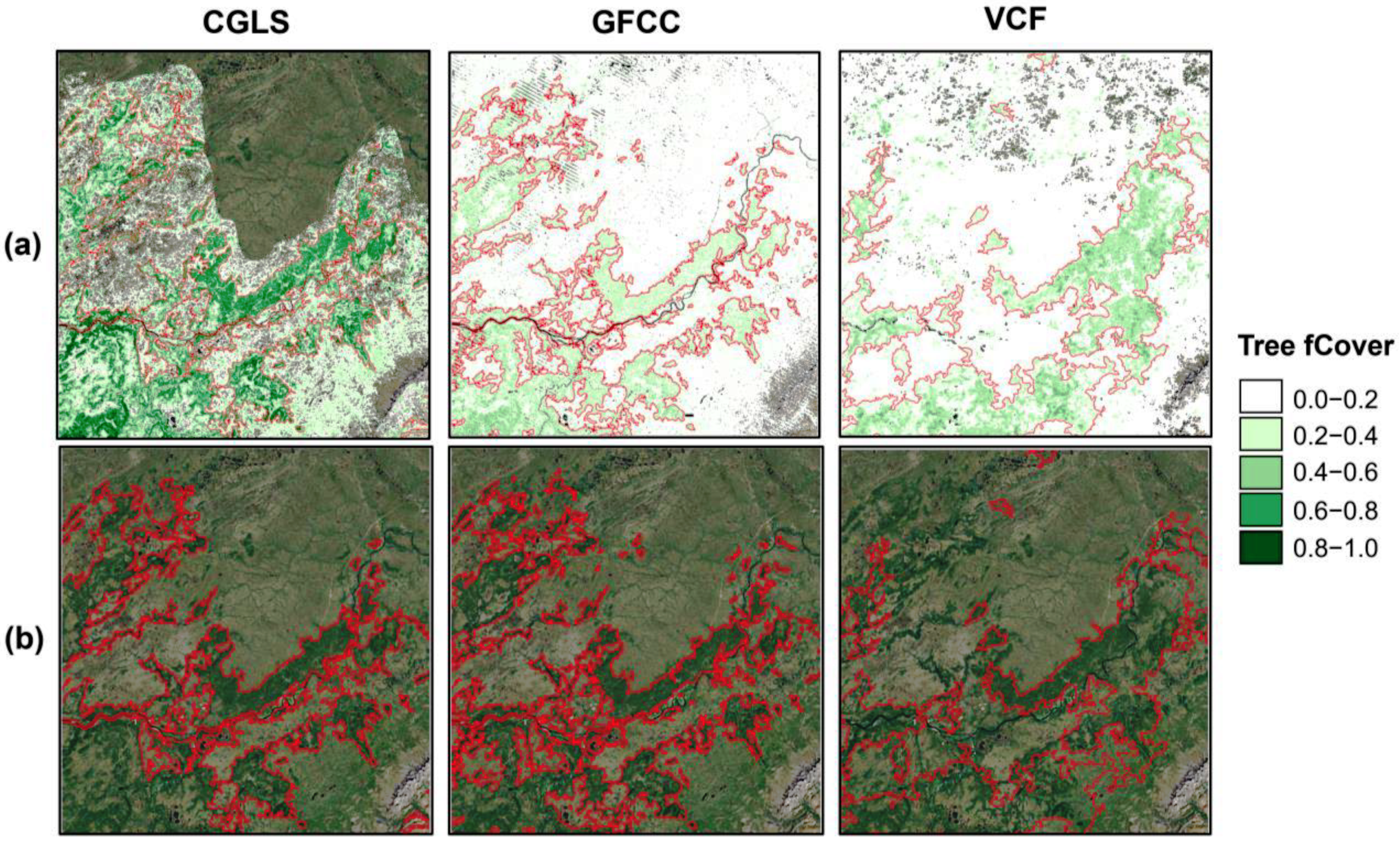
| Type | Definitions | Objective | Data | Source |
|---|---|---|---|---|
| Taiga | Tree fCover >0.3 | Local Arctic TTE mapping | Landsat-7, MISR, MODIS, RADARSAT | [29] |
| Forests | Tree fCover >0.2 (height > 5 m) | Pan-Arctic TTE mapping | MODIS vegetation continuous fields (VCF), Quickbird | [12] |
| Intermediate—Closed forests | Tree fCover >0.3 (height > 5 m) | Pan-Arctic TTE mapping | Landsat global forest cover change (GFCC) | [11] |
| Closed forests | Tree fCover >0.3 (height > 2 m) | Local Alpine treeline mapping (timberline) | Repeat photography, dendrochronological analysis, field observations | [15] |
| Forests | Tree fCover >0.1 (height > 5 m) | - | - | FAO |
| Test Areas | Minimum | Maximum | Median | Standard Deviation |
|---|---|---|---|---|
| Site A | 4.93 | 96.02 | 46.58 | 23.17 |
| Site B | 25.95 | 189.93 | 103.88 | 46.39 |
| Site C | 2.70 | 172.49 | 54.73 | 38.85 |
| Site D | 0.32 | 341.49 | 68.00 | 53.32 |
| Site E | 0.31 | 144.56 | 38.15 | 30.35 |
| Site F | 1.27 | 216.48 | 51.41 | 45.29 |
| Site G | 0.71 | 115.35 | 32.22 | 29.32 |
| Site H | 0.35 | 175.22 | 37.01 | 48.37 |
Disclaimer/Publisher’s Note: The statements, opinions and data contained in all publications are solely those of the individual author(s) and contributor(s) and not of MDPI and/or the editor(s). MDPI and/or the editor(s) disclaim responsibility for any injury to people or property resulting from any ideas, methods, instructions or products referred to in the content. |
© 2025 by the authors. Licensee MDPI, Basel, Switzerland. This article is an open access article distributed under the terms and conditions of the Creative Commons Attribution (CC BY) license (https://creativecommons.org/licenses/by/4.0/).
Share and Cite
Zhang, T.; Kumar, J.; Hoffman, F.M.; Ivanov, V.; Wang, J.; Sheshukov, A.Y.; Zhou, W.; Montesano, P.; Liu, D. A Region-Growing Segmentation Approach to Delineating Timberline from Satellite-Derived Tree Fractional Cover Products. Remote Sens. 2025, 17, 2002. https://doi.org/10.3390/rs17122002
Zhang T, Kumar J, Hoffman FM, Ivanov V, Wang J, Sheshukov AY, Zhou W, Montesano P, Liu D. A Region-Growing Segmentation Approach to Delineating Timberline from Satellite-Derived Tree Fractional Cover Products. Remote Sensing. 2025; 17(12):2002. https://doi.org/10.3390/rs17122002
Chicago/Turabian StyleZhang, Tianqi, Jitendra Kumar, Forrest M. Hoffman, Valeriy Ivanov, Jingfeng Wang, Aleksey Y. Sheshukov, Wenbo Zhou, Paul Montesano, and Desheng Liu. 2025. "A Region-Growing Segmentation Approach to Delineating Timberline from Satellite-Derived Tree Fractional Cover Products" Remote Sensing 17, no. 12: 2002. https://doi.org/10.3390/rs17122002
APA StyleZhang, T., Kumar, J., Hoffman, F. M., Ivanov, V., Wang, J., Sheshukov, A. Y., Zhou, W., Montesano, P., & Liu, D. (2025). A Region-Growing Segmentation Approach to Delineating Timberline from Satellite-Derived Tree Fractional Cover Products. Remote Sensing, 17(12), 2002. https://doi.org/10.3390/rs17122002










